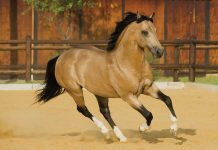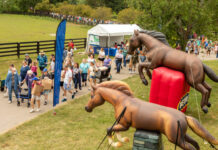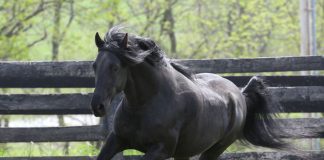The canter is a fun gait to ride, when it’s correct and controlled. Unfortunately, many riders run into problems with the canter because there are a lot of little details that need to be just right. With the correct technique and a lot of practice, you’ll get the hang of it.
Rider Position
Once you’re in the canter, remember to keep your weight in your heels and your butt in the saddle. Allow your seat to move with the motion of your horse, and use it to keep him moving forward. Don’t lean forward or backward.

A Balanced Horse
If your horse is pulling on the reins, he’s not balanced. He needs to use his hindquarters to push himself forward. When he does this, the reins will be light in your hands. You can test your horse’s ability to stay balanced by allowing some slack in the reins; he should maintain the proper frame.
Your horse must travel straight too. He shouldn’t be bent too much or push his hind end toward the inside or outside of the arena. If he’s crooked, correct him with your rein and leg aids. For example, if you’re traveling left and your horse’s hindquarters are out of line toward the outside of the arena, close your right hand around the outside rein. Then, push his haunches back onto the straight line with your right leg. Keep your left leg on so he doesn’t move his hind end toward the inside of the arena.
Ready to Go
Make sure your horse is ready for the canter by giving him a heads up with your riding aids. First, gently close your hands around the reins. This doesn’t mean you pull; you’re just adding some resistance. Follow this right away with pressure from both legs to ask your horse to bring his hind legs underneath him and move forward into your reins. This is called a half-halt. It will encourage him to get into the round, balanced frame that’s necessary for a correct canter.
Off to a Good Start
If you want to get a good canter, you have to ask the right question of your horse. For the left lead, gently close your right hand around the outside rein and steadily squeeze and release on the inside rein with your left hand. At the same time, add pressure with your left (inside) leg at the girth. This will ask your horse to soften and bend in preparation for the canter. Your right leg should be just behind the girth to catch him so he doesn’t bend too far or try to move sideways toward the rail.
When you feel like you and your horse are ready, move your right leg back a little farther and give your horse a bump with it. If he doesn’t respond right away, tap him behind your right leg with your whip. It’s important to start with light cues and then build them up if you don’t get the right answer from your horse. Otherwise, you’ll always have to use really strong aids, until your horse eventually won’t listen to them at all! When you start with light cues and then build, your horse will soon get the idea that he needs to listen to the lightest cue.
Handy Helpers
It’s easier to ask for the canter from a sitting trot because you’ll be in a better position to prepare your horse, and he’ll already be moving forward. You can try it from the walk as he gets better.
Asking your horse to canter in the corner of the arena will help him because it encourages him to bend in the direction of travel, making it easier for him to pick up the correct lead. Choose a corner and think about doing your preparations on the long side before it. When you get the canter, continue in a circle at the end of the arena. The rail and the shape of the circle will help him maintain the correct lead and frame. Be sure you keep your legs on to prevent him from falling in or moving out on the circle.
Keep your horse cantering for a few strides and then come back to the trot and repeat. It’s important that he learn to always canter in the right frame. Horses can lose it if asked to canter for too long in the beginning, and that only teaches them bad habits. As your horse improves, you can increase the amount of time you ask him to hold the canter, until you’re eventually soaring around the whole arena!
If your horse ever picks up the wrong lead, bring him back to a trot right away. Prepare him and ask for the canter again. Letting him continue cantering on the wrong lead will make him think he’s doing it the right way. Then he might want to pick up the wrong lead every time. Plus, it doesn’t help him develop the physical conditioning he needs to canter correctly.
Remember that every horse has a good side and a bad side, just like humans. If you’ve been riding your horse for a while, you’ll know which side is his good one. Everything is generally easier and smoother on that side. Practice the canter on your horse’s good side first to boost his confidence, and yours! But always remember to canter in both directions.
Lead Problems
If you’re having problems getting your horse to take the correct lead, try placing a pole in the corner of the arena and ask for the canter as you pop over the pole. Most horses will land on the correct lead if they take off at canter over a pole.
This article originally appeared in the September/October 2013 issue of Young Rider magazine. Click here to subscribe!





